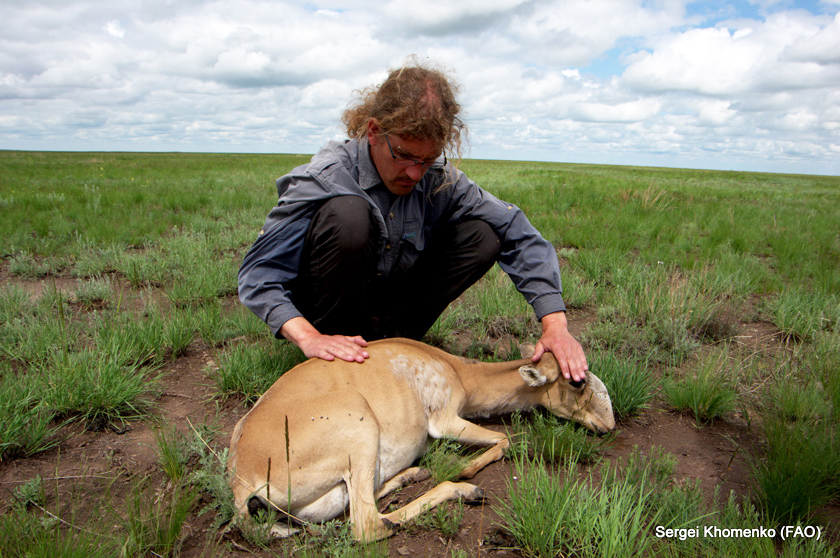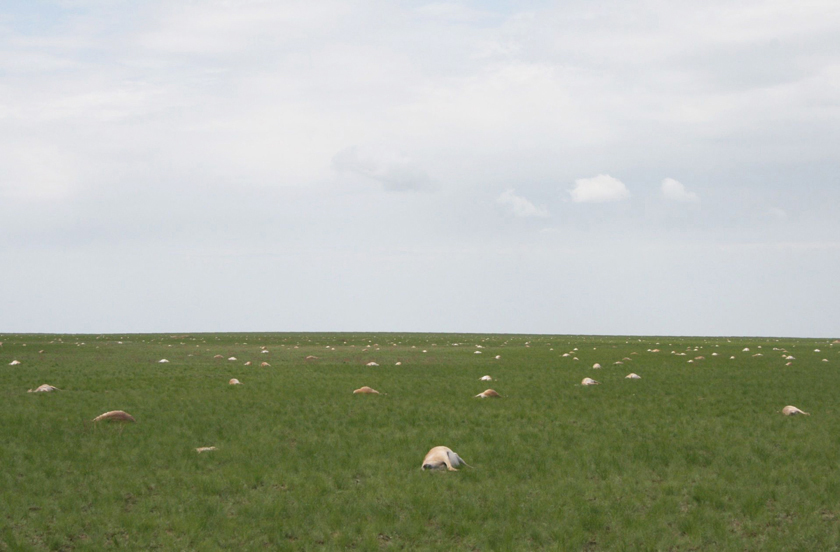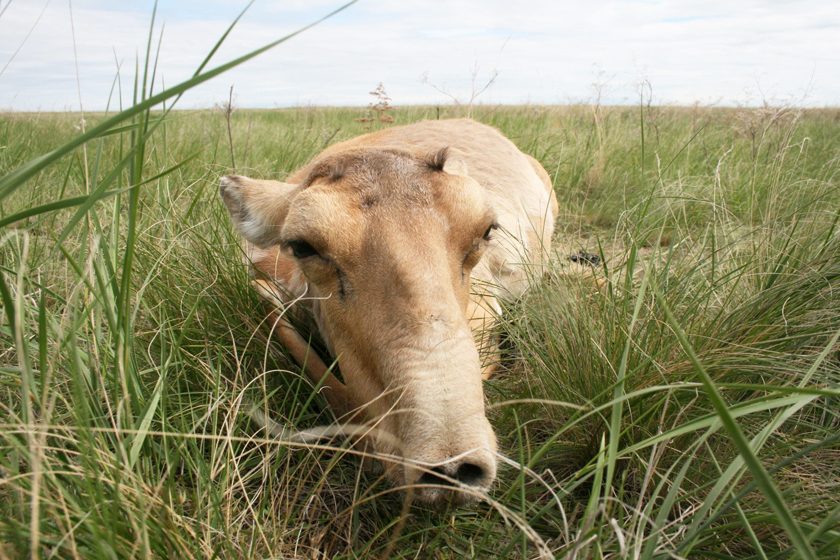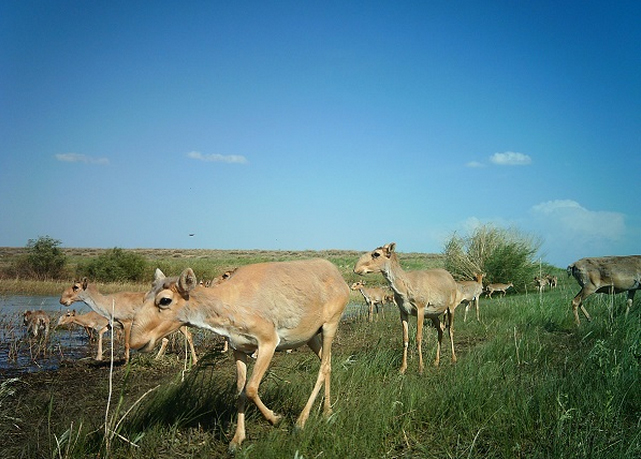As Antelope Die-Off Ends, The Mystery Deepens
Nearly half the world’s population of the saiga died in just the past few weeks. Now, scientists are digging in to find out why.
By Vicki Croke

Steffen Zuther, acting director of the Association for the biodiversity of Kazakhstan, was among the first witnesses on the scene. Photo: FAO/Sergei Khomenko.
The dying may be over but the accounting has just begun.
More than a hundred thousand antelope have perished in one area in just a few weeks and scientists are left with no idea—yet—of what caused it or why it has extinguished itself.
That’s the strange and deadly mystery playing out right now in Kazakhstan among the herds of a critically endangered kind of antelope called the saiga. The herd animals have dropped dead in the thousands—at least 127,000 gone, according to the official estimate, since mid-May.
It seems to have stopped as mysteriously and abruptly as it began, leaving perhaps only half the world’s population (about 250,000 last year) of saiga alive.

Steffen Zuther observed the devastation: whole herds lying dead—the carcasses of calves curled up at the bellies of their dead mothers. Photo: Steffen Zuther.
Last month, biologists and conservationists came to the saiga calving areas to see the beginning of life—babies being born by the thousands—but instead, what they witnessed was the end of life—with the carcasses of tens of thousands strewn over the terrain. Steffen Zuther, acting director of the Association for the Conservation of Biodiversity of Kazakhstan, was among the first witnesses on the scene. On May 10 and 11 and in the days that followed, he observed the devastation: whole herds lying dead—the carcasses of calves curled up at the bellies of their dead mothers.
In a Skype interview from Astana, Kazakhstan, Zuther told me about the start of this die-off. Within two days of his arrival in the field, he says, “most of the calving herd was dead.”
The catastrophic collapse was reported in New Scientist
The animals began dying from an unidentified cause around 10 May. The death toll soared within days to 27,000, at which point the Kazakh government requested help from the secretariat of the convention [UN Convention on Migratory Species.]. A team of vets, led by Richard Kock of the Royal Veterinary College in Hatfield, UK, flew out on Friday.
“It’s very dramatic and traumatic, with 100 per cent mortality,” Kock told New Scientist from Betpak-Dala in central Kazakhstan. “I know of no example in history with this level of mortality, killing all the animals and all the calves.” The animals die through severe diarrhoea and difficulty breathing.
Zuther says the die-off has essentially ended, but the race is on to find the cause. Scientists are on scene, conducting necropsies, or animal autopsies, and analyzing tissue. Though they think two kinds of bacteria (pasteurella and clostridia) have contributed to the deaths, they don’t believe they are the main culprits. That’s because these kinds of bacteria are usually present in healthy saiga as well. Most likely, that means something is affecting the immune system and allowing the bacteria to turn deadly.
A video clip from the International Fund for Animal Welfare showing a newborn saiga antelope calf in the Steppe getting up and running off. Courtesy of IFAW Russia.
[youtube=https://youtu.be/6ZOBJCTPEu0]
Could the problem have anything to do with climate change? Pollution? Digestive problems from vegetation that was more lush and moist than usual? Even a fuel spill from a rocket crash? There has been a lot of speculating. And soil, air, and water samples have been collected.
If all goes well, Zuther expects an answer within perhaps three weeks.
A die-off for the saiga is not new. In terms of numbers, this one might be unprecedented, but over the years, there have been several other unexplained mass deaths in saiga.
According to Henry Nicholls in Nature
Saigas are known to be prone to massive, as yet unexplained die-offs. These usually occur when the females come together to calve in the spring. In 1984, such an event in the Ural Mountains resulted in the loss of 100,000 animals — 67% of the local population. There were several smaller scale die-offs in the 2000s. But this year’s mass-death event among animals living in the Betpak-Dala region of Kazakhstan is much more significant as entire herds are dying.
So what is happening and how can conservationists stop it?
According to Nature:
The cause is unlikely to have been an infectious agent that was transmitted from one animal to the next. “Epidemiologically, you cannot get a directly transmitted disease to kill a whole population in seven days,” says Kock. “I’d say it’s a polymicrobial disease,” he says. This involves pathogens such as pasteurella and clostridia that are often present in the body but have seized an opportunity to run riot.
The pathogens may have been responsible for the deaths, but something must have caused the saigas to fall victim to them. Given that two discrete sub-populations some 300 kilometres apart suffered similarly and simultaneously, it seems likely that an environmental factor is part of the story.
The saiga, who live in large herds in central Asia in steppe grasslands and semi-desert grasslands, are curious-looking antelope. We think of antelope as elegant and long-legged, while the saiga is a bit more like an old-school Volvo—boxy and sturdy. They run with their heads down and their carriage has been compared to that of “a scurrying rodent.” It’s easy to see why scientists weren’t sure where to place them taxonomically and they were originally lumped together in the same genus as goats.

It’s believed that the saiga’s bulbous noses are built to cool and warm air and to filter out dust. Photo: Steffen Zuther.
But they are well-built for their lifestyle. They can cover 50 miles a day during migration, and are fast runners—said to reach speeds of 48 mph.
It’s suspected that their large, flexible noses are engineered perfectly for a few important tasks in this harsh environment: warming frigid air in winter, cooling hot air in summer, and filtering out the dust that the herds kick up during migration.
Though the largest numbers are in Kazakhstan, there are saiga also in Russia, Uzbekistan, Kirghizstan and Mongolia.
Even without the die-offs, the fortunes of the saiga, a species that’s been around since the ice age, have fluctuated over time. Large-scale hunting and poaching has hit them hard. For instance, in the 1990s, when the USSR broke up, hunters supplying horns for use in traditional Chinese medicine killed an estimated 95 percent of the population. New protections in Kazakhstan, which holds three populations of the animals, have helped the population grow. (There are concerns now that poachers will dig up the buried carcasses from the die-off to salvage the horns. Zuther confirms that some people helping in the burial were in fact charged with taking some horns. One conservationist I spoke to said the government of Kazakhstan could build a bonfire of these horns in order “to make a statement saying, ‘We don’t approve of this illegal trade.’”)
Illness has been known to rip through other species of herd animals throughout history.

Camera trap photo of a saiga herd. Courtesy of the Association for the Conservation of Biodiversity of Kazakhstan.
For perspective, I called George Schaller. He is perhaps the greatest field biologist of our time—a man who has pioneered the study of a number of species all over the world, including mountain gorillas, lions, giant panda, tigers, and cheetah. He has spent a great deal of time in Mongolia and has watched saiga there.
In Mongolia, he witnessed a substantial die-off of Mongolian gazelles from foot rot, but, he says, the Wildlife Conservation Society, was in a good position to analyze and help because of the close monitoring they had been conducting. Schaller mentions a very famous case in history—when domesticated cattle spread rinderpest, a viral disease, to wildebeest in East Africa in the late 1800s. “But since then in the Serengeti,” Schaller says, “this has been closely monitored.”

George Schaller says, “To see the beauty of these big herds–it touches your heart.” Photo: Kay Schaller.
Zuther says there is livestock in the area of the saiga calving, but so far they seem very healthy. He agrees that close monitoring is vital and says that there are now much better programs in place with the expertise to accomplish that.
Why should we save the saiga? Schaller is both scientific and philosophical when he answers the question.
“Well you know these migratory populations—whether you’re talking about caribou or the million Mongolian gazelles that still exist—their migrations define their habitat. It’s a natural spectacle. To see the beauty of these big herds—it touches your heart. You want to protect the whole landscape that they need for their migration. You protect the habitat and all the thousands of other species of animals at the same time. So just the saiga alone—if Kazakhstan and the other countries are serious, they also protect themselves for the future.”

12 Responses to “As Antelope Die-Off Ends, The Mystery Deepens”
Fungal spores should be checked
Sounds more like a toxin. Missing something something environmental that they ingested. Water algae bloom?
chemical weapons testing should be checked too. How tragic!!
Chemical Weapons, yes. Weaponized biological agents. Evil Politicians
Lush vegetation and abundant standing water would equal grass tetany in cattle. Has anyone considered this for the saiga ? Magnesium defiency? Sometimes it’s the simplest things that get overlooked.
“Other than a cold, hard winter followed by a spring with lots of lush vegetation and lots of standing water on the ground, there wasn’t much unusual in the conditions this year, biologists say….”
-Livescience article on saiga death epidemic
Is Selenium contamination possible?
Someone should check for signs of electrical shock. The Baikonur Cosmodrome nearby has many high power, high gain microwave space radars and high gain microwave earth stations. I think the electrical power is “grounding out” into the wet Earth during storms and wet, damp conditions and shocking the antelope. 10 mA can be felt on the skin and 100 mA can stop a mammals heart. I have lots of wildlife epidemiology maps on my blog that point to a problem around high power, high gain antennas. Electromagnetic radiation, refraction, reflection, induction, coupling and conduction (shock) of wildlife
This is pretty unlikely I think, given how the field strength is inversely proportional to the square of the distance from the field generator.
There should be a clearly defined radiating pattern from the source, with teens of thousands dead near the field and just a few further away.
Something like that would be visible even to a casual observer.
Ruminants generate lots of methane and ammonia.
Methane + Ammonia + Microwave Radiation = hydrogen cyanide(poisonous) + dead saiga(depressed breathing, internal bleeding, convulsions, frothing at mouth)
https://web.anl.gov/PCS/acsfuel/preprint%20archive/Files/13_4_NEW%20YORK_09-69_0331.pdf
It’s called Prussia acid poisoning:
http://www.wired.com/2012/06/cyanide-and-poisoned-cows/
“This is pretty unlikely I think, given how the field strength is inversely proportional to the square of the distance from the field generator.”
This is an incorrect statement for a non-isotropic radiator like a high gain parabolic transmitting antenna. The beam can be super refracted into the ground hundreds of kilometers away from the dish.
For 3 typical tracking antennas, they exceed the FCC safe power density 392 kilometers from the antennas
http://darkmattersalot.com/2015/10/01/succumbedsaigasaga-say-3-times-fast/
Toxic shock syndrome . all the female died right after birth. This could have been and infection in the uterus that cause their death.
Maybe its the book of revelations happening right in front of us??
Comments are closed.